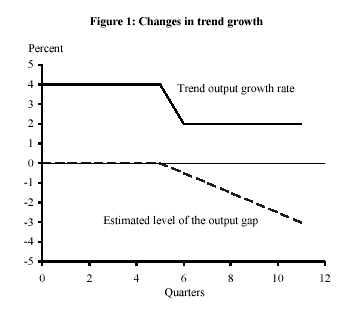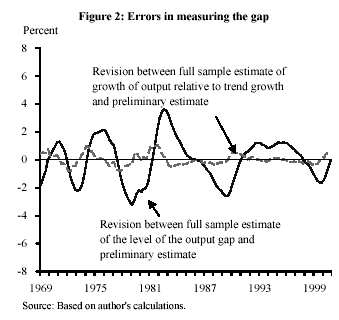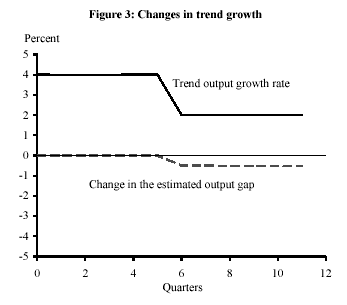Economists generally agree on the importance of low and stable inflation as a primary goal of monetary policy, as well as on the key role of inflation and forecasts of future inflation in providing critical signals to which the Fed needs to react. Economists also agree that the measure of real activity relevant for monetary policy is the gap between the level of actual output and an underlying trend level of output.
- Measurement problems
- Time inconsistency and policy biases
- Does the Fed follow a speed limit policy?
- References
Economists generally agree on the importance of low and stable inflation as a primary goal of monetary policy, as well as on the key role of inflation and forecasts of future inflation in providing critical signals to which the Fed needs to react. Economists also agree that the measure of real activity relevant for monetary policy is the gap between the level of actual output and an underlying trend level of output. Most central banks view such an output gap as both a policy objective to be stabilized and as an important signal of future inflation developments. However, some economists argue that difficulties in measuring the economy’s underlying trend output level make any estimate of the output gap too poorly measured to be a useful guide for monetary policy.
This Economic Letter discusses policies that focus on whether the economy is growing faster or slower than trend output rather than on what the level of output is relative to the level of trend output. Such policies are called “speed limit policies,” where the growth rate of trend output represents the economy’s safe sustained speed limit–faster growth generates inflation over time, and slower growth leads to increased unemployment. When actual output grows faster than trend, the output gap is increasing; when actual output grows more slowly than trend, the gap is falling. Speed limit policies, therefore, focus on how the output gap is changing rather than on its level. Speed limit policies may alleviate some of the measurement problems that affect estimates of the level of the gap; they also may impart a persistence to policy actions that improves the trade-off between inflation and output stability.
The output gap measures actual output relative to some benchmark level. Recent theoretical work suggests that the benchmark should be the level of output that occurs when all wages and prices are flexible and adjust to balance supply and demand in all markets. Since not all wages and prices are flexible, this output level cannot be observed directly, so in practice, the benchmark is commonly interpreted to be the trend level of output. But there are many different ways to estimate trend output, and each can give conflicting signals about whether the output gap is positive or negative, large or small.
Orphanides (2000) has provided evidence that the problems of mismeasuring the output gap produced policy mistakes during the 1970s. Today, with hindsight, we know that productivity growth slowed in the early 1970s. At the time, however, this was not clear. As a result, policymakers overestimated the level of trend GDP and therefore believed the output gap (actual output minus the estimated trend level) was more negative than it actually was. Over time, these errors grew in size as trend output fell further and further below the estimated level. To counteract what was thought to be a weak economy, the Fed followed an expansionary policy, contributing to the high inflation the U.S. experienced during this period. In light of Orphanides’s research, some economists have argued that the output gap is measured so poorly it should not be given much importance in Fed deliberations (McCallum 2001).
 Figure 1 illustrates this problem in the simple case where the growth rates of actual output and trend output fall from 4% to 2%. If the central bank continues to believe the trend growth rate is 4%, the dotted line shows how the estimated output gap would grow over time, even though the actual gap remains at zero; a central bank focusing on the level of the estimated gap would believe larger and larger interest rate cuts were required.
Figure 1 illustrates this problem in the simple case where the growth rates of actual output and trend output fall from 4% to 2%. If the central bank continues to believe the trend growth rate is 4%, the dotted line shows how the estimated output gap would grow over time, even though the actual gap remains at zero; a central bank focusing on the level of the estimated gap would believe larger and larger interest rate cuts were required.
Real-time errors in predicting the economy’s trend output arise from two sources. First, the predictions depend on currently available data on GDP, which are revised over time as more information becomes available. Second, even if completely accurate data were immediately available, trend GDP still would be difficult to estimate. For example, only as more time passes will it be possible to tell how much the technology boom of the late 1990s altered the economy’s trend growth rate–our assessment of trend growth in the 1990s will be better in, say, 2010 when we can look both backward from 1990 and forward in time to the first decade of the 2000s to see how the economy has grown. According to Orphanides and van Norden (2002), this second source of error, not data revisions, is the major problem in measuring the current level of trend output and therefore in measuring the output gap.
 One way to assess measurement errors in the output gap is to compare estimates made today based on data for the period 1970-2002–“final estimates”–to the preliminary estimates that could have been formed just looking backward from each date in time. These two estimates of trend output can be combined with data on actual GDP to obtain two different measures of the output gap. The difference between the two estimates reflects revisions in the estimated level of trend output and provides an estimate of the importance of measurement error. The solid line in Figure 2 shows the difference between preliminary and final estimates of the level of the gap; clearly, these differences can be quite substantial. The dashed line shows the differences in the estimated growth rate of output relative to trend growth (the speed limit), which are much smaller than those in the level measure.
One way to assess measurement errors in the output gap is to compare estimates made today based on data for the period 1970-2002–“final estimates”–to the preliminary estimates that could have been formed just looking backward from each date in time. These two estimates of trend output can be combined with data on actual GDP to obtain two different measures of the output gap. The difference between the two estimates reflects revisions in the estimated level of trend output and provides an estimate of the importance of measurement error. The solid line in Figure 2 shows the difference between preliminary and final estimates of the level of the gap; clearly, these differences can be quite substantial. The dashed line shows the differences in the estimated growth rate of output relative to trend growth (the speed limit), which are much smaller than those in the level measure.
This suggests that, rather than ignoring the output gap altogether, policymakers might be better off focusing on the gap between the growth rate of output and the growth rate of trend output, essentially the change in the output gap. This type of focus was described by Federal Reserve Governor Edward Gramlich in a 1999 speech:
Solving a standard model of the macroeconomy, such a policy would effectively convert monetary policy into what might be called a “speed limit” form, where policy tries to ensure that aggregate demand grows at roughly the expected rate of increase of aggregate supply, which increase can be more easily predicted.
 Gramlich’s description of a speed limit policy explicitly recognizes the difficulties in measuring the level of trend output (aggregate supply) and argues that its growth rate can be more easily predicted. When actual output grows faster than trend output, policy should tighten; when actual output grows more slowly than trend, policy should ease. The dashed line in Figure 3 shows the change in the estimated output gap after a drop in trend growth. A central bank that focuses on this measure would cut interest rates in response to the initial decline in the output gap but would not engage in further cuts
Gramlich’s description of a speed limit policy explicitly recognizes the difficulties in measuring the level of trend output (aggregate supply) and argues that its growth rate can be more easily predicted. When actual output grows faster than trend output, policy should tighten; when actual output grows more slowly than trend, policy should ease. The dashed line in Figure 3 shows the change in the estimated output gap after a drop in trend growth. A central bank that focuses on this measure would cut interest rates in response to the initial decline in the output gap but would not engage in further cuts
Time inconsistency and policy biases
Another appeal of speed limit policies is that they seem to produce good outcomes when the public’s expectations of inflation matter for current inflation and output. In particular, speed limit policies help alleviate a policy problem known as the time-inconsistency of optimal policy (see Dennis 2003). The heart of the problem is that people’s decisions today may depend on what they believe the central bank will do in the future. Specifically, price- and wage-setting decisions by households and firms depend on what they think inflation will be in the future.
This dependence has important consequences for the trade-offs between inflation and output stability the central bank faces. For example, suppose an adverse economic shock, such as a rise in oil prices, both raises inflation and reduces output. To dampen the rise in inflation, the central bank would need to raise interest rates, but this would exacerbate the decline in output. If the central bank could commit to maintaining a tight monetary policy for some time into the future, the public would expect lower inflation in the future, and that would help dampen the current inflationary impact of the oil shock. Current inflation could be stabilized with a smaller, but persistent, fall in output.
The problem, as Dennis (2003) explains, arises if the public believes the central bank is trying to stabilize both inflation and the output gap. In particular, if the central bank succeeds in holding down current inflation, albeit with some fall in output (and the associated rise in unemployment), it no longer has an incentive to maintain its tight policy; instead, it will reverse itself and switch to an expansionary policy to close the output gap. With this belief in mind, the public will not expect lower future inflation when the oil price shock occurs, and the only way the central bank can dampen the rise in inflation is to slam on the brakes to slow economic activity.
Following a speed limit policy obviates this problem. In this case, when an adverse oil shock occurs, policy is tightened to stabilize inflation; unemployment rises and the output gap falls. In subsequent periods, however, the central bank will look at how the output gap changes rather than at its level. Thus, it will not switch its policy stance simply because the gap remains negative; it will become more expansionary only if the gap becomes more negative (or inflation begins to fall). A speed limit policy generates a more persistent tightening than does a policy that focuses on the level of the gap. As a consequence, when an adverse oil price shock occurs, the public will expect lower future inflation, and this helps stabilize current inflation.
Using an economic model in which expectations are important for determining inflation, Walsh (2003) finds that speed limit policies stabilize inflation and the output gap better than do policies that focus directly on the level of the output gap. The persistence introduced by speed limit policies improves the trade-off between output and inflation variability faced by the central bank. However, such policies do not do as well when expectations are less important for determining inflation (Rudebusch 2002).
Does the Fed follow a speed limit policy?
The preceding discussion suggests that the problems of measurement errors and stabilization may be alleviated by a speed limit policy. A separate issue is whether the Fed has actually behaved in a manner consistent with a speed limit policy as described in Governor Gramlich’s speech.
Yash Mehra (2002) has estimated policy rules to explain the Fed’s behavior, and he finds that a Taylor rule using the change in the output gap does as well in accounting for Fed policy during the Greenspan era as does a traditional Taylor rule using the level of the gap, providing some evidence that the Fed has minded the economy’s speed limit and not solely the output gap.
Carl E. Walsh
Professor of Economics, UC Santa Cruz,
and Visiting Scholar, FRBSF
References
Dennis, R. 2003. “Time-Inconsistent Monetary Policies: Recent Research.” FRBSF Economic Letter 2003-10 (April 11).
Gramlich, E.M. 1999. “Remarks,” Wharton Public Policy Forum Series, Philadelphia, PA (April 22).
McCallum, B.T. 2001. “Should Monetary Policy Respond to the Output Gap.” American Economic Review (May) pp. 258-262.
Mehra, Y.P. 2002. “Level and Growth Policy Rules and Actual Fed Policy since 1979.” Journal of Economics and Business 54(6) (Nov./Dec.) pp. 575-594.
Orphanides, A. 2000. “The Quest for Prosperity without Inflation.” European Central Bank Working Paper No. 15 (March).
Orphanides, A., and S. van Norden. 2002. “The Unreliability of Output Gap Estimates in Real Time.” Review of Economics and Statistics (November).
Rudebusch, G.D. 2002. “Assessing Nominal Income Rules for Monetary Policy with Model and Data Uncertainty.” Economic Journal 112 (April) pp. 402-432.
Walsh, C.E. 2003. “Speed Limit Policies: The Output Gap and Optimal Monetary Policy.” American Economic Review 93(1) (March) pp. 265-278.
Opinions expressed in FRBSF Economic Letter do not necessarily reflect the views of the management of the Federal Reserve Bank of San Francisco or of the Board of Governors of the Federal Reserve System. This publication is edited by Anita Todd and Karen Barnes. Permission to reprint portions of articles or whole articles must be obtained in writing. Please send editorial comments and requests for reprint permission to research.library@sf.frb.org